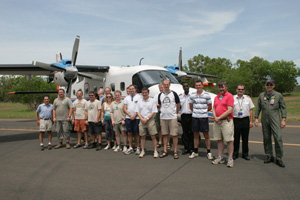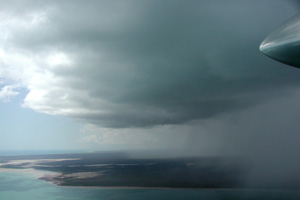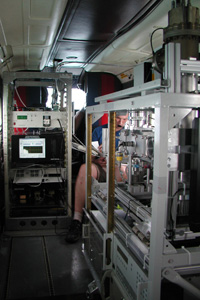ACTIVE Project-Dornier Measurements
The Dornier aircraft was equipped with instrumentation to characterise the low level inflow into the convective systems being studied, including thermal, aerosol and gas phase properties. More details of the measurements made, instruments used and the groups involved are given below. The Dornier was operated according to two general flight plans, depending on the specific objectives of the day’s flying. When flown in conjunction with other aircraft studying specific convective systems, especially those of an isolated nature, the Dornier flew around the base of the storm, as close to the storm as possible while keeping in cloud and precipitation free air. Horizontal legs were flown at different levels between 500 and 15000ft, additionally profile ascents and descents were carried out to establish the vertical structure of the atmosphere. On other days the Dornier was flown on surveys, both out to sea, and inland to establish a general climatology of air in the region.
Most of the instrumentation flown on the Dornier was installed in racks within the aircraft cabin, with external air being supplied to them via a passive near-isokinetic diffuser inlet system mounted on top of the aircraft fuselage, just behind the windscreen. The inlet tip protruded far enough from the aircraft skin to be outside the boundary layer flow immediately affected by contact with the aircraft. Air from this inlet was distributed via internal pipe work to the instruments. Tube lengths were kept as short as possible, with no sharp bends, and flow splitters were designed so as to match velocities in each branch, to reduce losses and preferential sampling of particular size ranges. Two instruments, the FSSP and the AIMMS probe were mounted externally in under-wing pods.
ARSF Measurements
ARSF operated the AIMMS-20 meteorology and turbulence probe. This instrument provided 3 dimensional wind measurements, as well as temperature, humidity and pressure. It also recorded GPS altitude and position information. This instrument was mounted in a standard PMS wing pod. ARSF also provided a separate GPS data stream which was logged by the Manchester logger and telemetered back to the ground for near real-time display of aircraft position.
University of Manchester Measurements
The Centre for Atmospheric Science operated instrumentation to characterise aerosol size distribution from 10nm to 47µm, and aerosol chemical composition in the size range 20 to 1000nm. The instruments used for these measurements were the Quadrupole Aerosol Mass Spectrometer (AMS), Ultra High Sensitivity Aerosol Spectrometer (UHSAS), GRIMM 1.108 optical particle counter, Aerosol Spectrometer Probe (ASP), TSI 3010 Condensation Particle Counter (CPC) and Forward Scattering Spectrometer Probe. Additionally filter samples were taken, for environmental scanning electron microscopy analysis, to determine the relative abundance of sea salt and desert dust in super-micron particles. The University of Manchester also operated and logged a PSAP instrument providing measurements of aerosol absorption, which was provided by Andreas Minikin of DLR, Germany.
University of York Measurements
The University of York operated instrumentation to characterise trace gas species: carbon monoxide (Aerolazer AL-5003), ozone (2B Technologies Model 202), oxides of nitrogen (Thermo Environ 42C-TL). Adsorbent tube samples were taken with an automatic tube sampler capable of taking up to 16 samples per flight. These samples were analysed post flight for C4-C9 aliphatics, acetone and monoterpenes which derive from a variety of natural and anthropogenic sources.
University of Cambridge Measurements
The University of Cambridge made measurements of halo-carbon species every five minutes throughout flights using a fully automatic µ-Dirac gas chromatograph instrument. Species measured included CFC-11 (reduced concentrations indicate that stratospheric air is sampled), CH3CCl3, CCl4, CHCl3, Halon-1211 (all industrial tracers), CHBr3, CH2Br2, and CH3I (an excellent tracer in marine boundary layer air).


